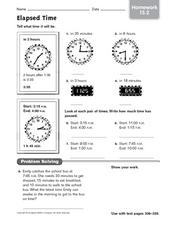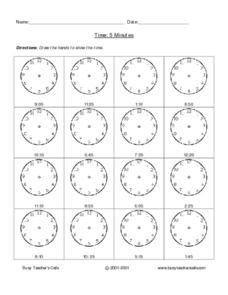Curated OER
What Hour Is It?
Telling time can be tricky business. This worksheet includes the images of four clocks, two for learners to read, and two for learners to complete. They write down the time they see and then draw in the missing hour hand.
Curated OER
Telling Time in Words
Writing out time can be tricky! Give your scholars practice with this pair of worksheets featuring both analog and digital clocks. They read the times and write it out in the boxes provided. Make sure you specify that learners are to...
Franklin College
Tell Time to the Nearest Half-hour and Relate to Events
Youngsters examine how to tell time to the nearest half-hour. They discuss why people wear watches, listen to the book "What Time Is It?" by Sheila Keenan, view examples on a model clock, and complete a worksheet with the teacher.
Curated OER
Morning Math
Mornings can be hard with sluggish mathematicians. Get them thinking using this set of 14 morning math problems. Pass these out or simply project them and have learners complete individual problems in their notebooks. Skills include...
Curated OER
Hours and Half Hours of Time- Matching Worksheet
What time is it? It's time to learn how to read analog and digital clocks! There are three analog and two digital clock faces here, each reading a time on the hour or half-hour. Learners examine and match them to the written-out versions...
Curated OER
Time
Introduce kids to the wonders of telling time. A variety of time telling devices are used to show what time it is. Kids will read each clock or watch to determine the correct time. Tip: This would be a great tool to use at an independent...
Curated OER
Telling Time as an Everyday Use of Numbers
How can we estimate time? Have your young mathematicians make a clock. Then they compare and contrast types of clocks. They practice writing times in two different ways and make a book about telling time.
Curated OER
Telling Time Bingo
Have your youngsters examine the difference between digital and analog clocks. Using They participate in a "Telling Time BINGO" game. Not only is this activity fun, but it provides the teacher with an opportunity to informally assess his...
Curated OER
Telling Time
Young learners participate in activities which help them understand analog clocks, and the vocabulary of telling time. They examine the values of the intervals of minutes and hours by making a human clock.
Curated OER
What Time Is It?
Are your learners practicing telling time? They use the nine clocks provided and write the corresponding time for each clock. If you're looking to extend this activity, have them tell a partner what they'd be doing at each time.
Curated OER
It's About Time
First, second, and third graders explore elapsed time through estimation and prediction. They work with a partner to estimate how long it will take to perform various tasks. One person uses a stop watch to time his or her partner...
Curated OER
Telling Time for Grade 3
Ten questions are provided to review elapsed time. Your third graders will like that some questions provide visual representations to guide learners. Use Internet Explorer if you want this worksheet to print in its proper format.
Curated OER
Elapsed Time - Problem Solving 13.2
In this reading a schedule worksheet, students use the movie schedule to answer the word problems about elapsed time. For the last problem, students use the length of three different movies to help them answer the question.
Curated OER
Elapsed Time - Reteach 13.2
In this telling time worksheet, learners learn three steps to tell how much times has passed using an analog clock. Students then tell what time it will be using the time descriptions and the clock hands.
Curated OER
Elapsed Time - Homework 13.2
In this telling time worksheet, students tell what time it will be use the description and the analog or digital clock times. Students then look at the pairs of times and write how much time elapsed between them. Students finally solve...
Curated OER
Time 5 Minutes
If your learners have already been introduced to telling time in five-minute intervals, this resource will provide extra practice! Or consider using it as a formal assessment. Have your learners developed time-telling skills?
Curated OER
Telling Time Worksheet: Drawing Hands on a Clock
Can your learners tell time? Give them practice with this resource. For each of nine clocks, youngsters must use the numerical time to draw the hands on the clock.
Curated OER
Telling Time By 5 Minute Increments
Young learners practice telling time from analog clock illustrations. There are nine illustrations here, all illustrating increments of five. You could use this worksheet for practice or a short quiz.
Curated OER
Telling Time With Clocks/Bingo “Time”
Young learners create a clock by adding hands and placing the numbers in the correct location. After each learner has their very own clock, they explore each component. Review on the hour times, and then introduce them to five-minute...
Curated OER
What Time is it? (A)
First and second graders learn how to tell time using illustrations of an analog clock. Eight clocks are shown, each representing a different five-minute interval. Answers are provided on the second sheet.
Curated OER
Hickory Dickory Doc Tell Time
Learners discover time keeping by reading clocks. In this time-telling instructional activity, students read the story Hickory Dickory Dock, and discuss the measurements of time we use. Learners complete worksheets in which they...
Curated OER
How Clocks Work
Learners discover time pieces and complete telling time activities. In this time instructional activity, students complete a worksheet about what make a clock keep time. Learners watch a video about time and clocks as well as a video...
Curated OER
Tick Around the Clock
Learners examine and discuss the differences between clocks they are shown. Using the internet, they research how people used to tell time before clocks. They review what the long and short hand on the clock represent and practice...
Curated OER
What Time Is It? Nearest Minute
In this telling time worksheet, learners study 9 clocks and determine the time to the nearest minute. Students write the correct time under each clock.

























